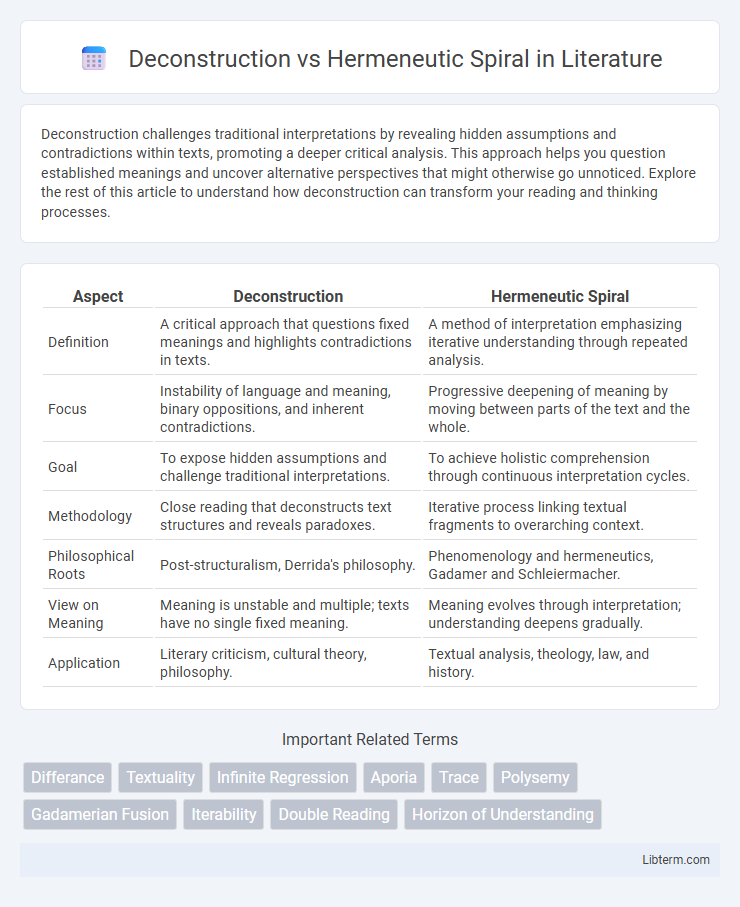Deconstruction challenges traditional interpretations by revealing hidden assumptions and contradictions within texts, promoting a deeper critical analysis. This approach helps you question established meanings and uncover alternative perspectives that might otherwise go unnoticed. Explore the rest of this article to understand how deconstruction can transform your reading and thinking processes.
Table of Comparison
| Aspect | Deconstruction | Hermeneutic Spiral |
|---|---|---|
| Definition | A critical approach that questions fixed meanings and highlights contradictions in texts. | A method of interpretation emphasizing iterative understanding through repeated analysis. |
| Focus | Instability of language and meaning, binary oppositions, and inherent contradictions. | Progressive deepening of meaning by moving between parts of the text and the whole. |
| Goal | To expose hidden assumptions and challenge traditional interpretations. | To achieve holistic comprehension through continuous interpretation cycles. |
| Methodology | Close reading that deconstructs text structures and reveals paradoxes. | Iterative process linking textual fragments to overarching context. |
| Philosophical Roots | Post-structuralism, Derrida's philosophy. | Phenomenology and hermeneutics, Gadamer and Schleiermacher. |
| View on Meaning | Meaning is unstable and multiple; texts have no single fixed meaning. | Meaning evolves through interpretation; understanding deepens gradually. |
| Application | Literary criticism, cultural theory, philosophy. | Textual analysis, theology, law, and history. |
Introduction to Deconstruction and Hermeneutic Spiral
Deconstruction, rooted in Derrida's philosophy, challenges traditional interpretations by exposing contradictions and emphasizing the fluidity of meaning within texts. The Hermeneutic Spiral, central to interpretive theory, describes the iterative process where understanding deepens through the continuous interaction between the parts and the whole of a text. Both approaches prioritize dynamic engagement with textual meanings, yet Deconstruction disrupts inherent structures while the Hermeneutic Spiral seeks evolving comprehension through recursive analysis.
Philosophical Foundations
Deconstruction originates from Jacques Derrida's philosophy, emphasizing the instability of meaning and the inherent contradictions within texts, challenging fixed interpretations through a critical dismantling of language and concepts. The Hermeneutic Spiral, rooted in the works of Hans-Georg Gadamer and Martin Heidegger, focuses on the dynamic and iterative process of understanding, where interpretation evolves through a continuous dialogue between the interpreter's preconceptions and the text itself. Both approaches explore meaning, but deconstruction destabilizes meaning to reveal hidden biases, while the hermeneutic spiral seeks deeper comprehension through an ongoing interpretive interaction.
Key Proponents and Historical Context
Deconstruction, primarily associated with Jacques Derrida in the late 1960s, critiques traditional concepts of meaning by exposing inherent contradictions and ambiguities within texts, emerging from post-structuralist thought. The Hermeneutic Spiral, developed from the work of philosophers like Hans-Georg Gadamer and Martin Heidegger in the early 20th century, emphasizes the iterative process of understanding texts by moving between parts and wholes within historical and cultural contexts. Both methodologies respond to the challenges of interpretation but diverge in their approach, with deconstruction focusing on destabilizing meaning and the hermeneutic spiral on progressively deepening comprehension.
Core Principles of Deconstruction
Deconstruction centers on the core principle that texts contain inherent contradictions and multiple meanings, challenging the idea of a fixed, singular interpretation. It seeks to uncover hidden assumptions and power structures by analyzing language, binary oppositions, and inconsistencies within the text. Unlike the Hermeneutic Spiral, which aims for progressively deeper understanding through iterative interpretation, Deconstruction emphasizes the instability and fluidity of meaning itself.
Main Features of the Hermeneutic Spiral
The Hermeneutic Spiral emphasizes iterative interpretation, where understanding deepens through continuous interaction between the parts and the whole of a text, ensuring context is constantly re-evaluated. It involves a dynamic process of refining meaning by revisiting preconceptions and integrating new insights to achieve a more comprehensive comprehension. This model contrasts with deconstruction by focusing on constructive dialogue and meaning-building rather than fragmenting or destabilizing the text.
Methodological Differences
Deconstruction challenges traditional interpretative methods by emphasizing the instability of language and the multiplicity of meanings, often revealing contradictions within texts. In contrast, the Hermeneutic Spiral operates through iterative understanding, where interpretation deepens continuously by moving between the parts and the whole to construct meaning progressively. Methodologically, Deconstruction deconstructs assumptions to expose indeterminacy, while the Hermeneutic Spiral seeks coherent comprehension through dialectical engagement with the text.
Applications in Literary and Textual Analysis
Deconstruction emphasizes examining text contradictions and instability to reveal hidden meanings and challenge fixed interpretations, widely applied to postmodern literary analysis. The Hermeneutic Spiral involves iterative interpretation cycles, where understanding deepens by continuously revisiting the text and context, commonly used in biblical and philosophical studies. Both methodologies enhance critical reading but differ in approach: deconstruction destabilizes meanings while the Hermeneutic Spiral seeks evolving comprehension.
Strengths and Critiques of Deconstruction
Deconstruction excels in exposing hidden assumptions and contradictions within texts, revealing the instability of meaning and challenging traditional interpretations. Its strength lies in destabilizing dominant ideologies and opening diverse readings, yet critics argue it can lead to excessive relativism and obscure authorial intent. While deconstruction disrupts fixed meanings, it sometimes sacrifices clarity and coherent interpretation, limiting its practical application in structured hermeneutic analysis.
Advantages and Limitations of Hermeneutic Spiral
The Hermeneutic Spiral offers a dynamic and iterative approach to interpretation, allowing deeper understanding through continuous refinement of meaning between the parts and the whole. Its advantage lies in promoting an evolving comprehension that adapts with new insights, fostering contextual sensitivity and avoiding rigid conclusions. However, limitations include its potential for subjective bias as interpretations may vary widely, and the process can be time-consuming without guaranteeing definitive or absolute understanding.
Comparative Insights and Conclusion
Deconstruction challenges traditional interpretations by exposing inherent contradictions and ambiguities within texts, emphasizing the instability of meaning. The Hermeneutic Spiral, in contrast, promotes a cyclical process of interpretation where understanding deepens through iterative engagement with the text and context. Comparing both reveals that while deconstruction destabilizes fixed meanings, the hermeneutic spiral aims to progressively refine and expand comprehension, highlighting divergent approaches to textual analysis and meaning-making.
Deconstruction Infographic

 libterm.com
libterm.com